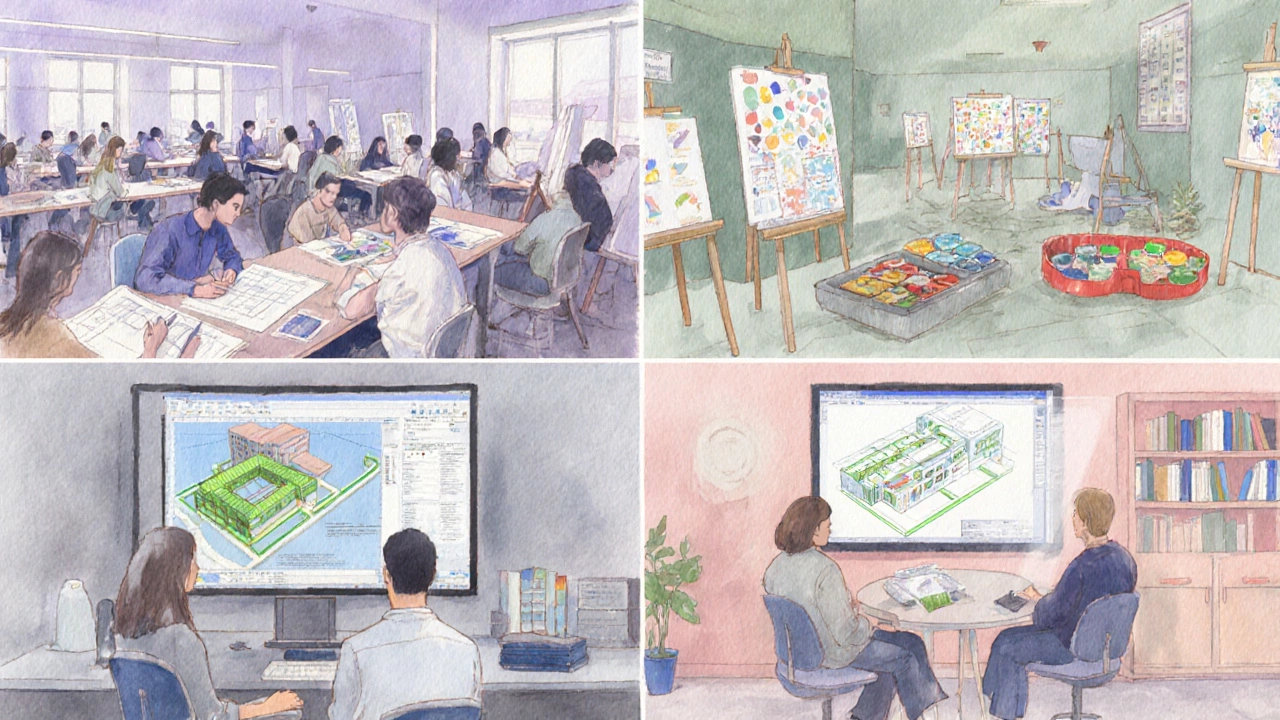Interior Design Degree Pathway Advisor
Recommended Degree Path
Selected Path Details
Why This Path?
Career Outcomes
Interior design degree is a formal education program that equips you with the skills to plan, style, and manage interior spaces. Whether you dream of creating cozy homes or sleek offices, the right credential can open doors, set salary expectations, and guide you toward licensure. Below you’ll find a straight‑to‑the‑point guide that cuts through the hype and helps you pick the path that matches your goals.
Key Takeaways
- Bachelor’s programs (BFA or BS) are the most common gateway into professional practice.
- Associate degrees are fast, affordable, and ideal for entry‑level jobs or portfolio building.
- Master‑level degrees suit designers aiming for leadership, research, or niche specialties.
- Accreditation by ACIIDE or CIDA is crucial for NCIDQ eligibility.
- Hands‑on experience-internships, real‑world projects, and a strong portfolio-often outweighs the specific degree name.
Understanding the Landscape of Interior Design Degrees
Today’s education market offers four main credential types:
- Associate of Applied Science (AAS) in Interior Design
- Bachelor of Fine Arts (BFA) in Interior Design
- Bachelor of Science (BS) in Interior Architecture
- Master of Interior Architecture (MIA) or related master’s degrees
Each serves a different audience, and the decision hinges on how quickly you want to start working, how deep you plan to dive into theory, and whether you need a license‑ready curriculum.
Associate Degrees: Fast‑Track to the Field
The Associate of Applied Science in Interior Design usually spans two years, blending drafting, material studies, and basic space planning. Community colleges and technical schools dominate this tier, keeping tuition under $10,000 in most U.S. programs.
Pros:
- Quick entry into the job market-most graduates land junior designer or drafting roles within six months.
- Lower cost and flexible schedules (often night or online classes).
- Solid foundation for a later bachelor’s transfer if you decide to upgrade.
Cons:
- Limited exposure to design theory, history, and research.
- Many firms prefer a bachelor's credential for senior or lead positions.
- Some states require a bachelor’s degree for licensure, so you may need to continue schooling.

Bachelor Degrees: The Industry Standard
Two main bachelor pathways dominate the market:
Bachelor of Fine Arts in Interior Design (BFA)
The BFA leans heavily into artistic development, color theory, and conceptual thinking. Programs typically require 120-130 credits and include studio courses, a capstone design studio, and a mandatory internship.
Bachelor of Science in Interior Architecture (BS)
The BS emphasizes technical skills-building codes, construction documents, and advanced computer‑aided design (CAD) tools. Graduates are well‑prepared for roles that intersect architecture and interior design.
Both degrees share core elements:
- Accreditation by ACIIDE or CIDA ensures the curriculum meets NCIDQ eligibility.
- A portfolio review in the final year determines graduation and job readiness.
- Typical salary after graduation: $45,000‑$60,000, with rapid growth after 2‑3 years of experience.
Master Degrees: Specialization and Leadership
If you already hold a bachelor’s and want to push into senior design, research, or academia, consider a Master of Interior Architecture (MIA) or a Master of Fine Arts (MFA) in Interior Design. Programs range from 30 to 48 credits and often require a pre‑existing portfolio.
Key benefits include:
- Advanced coursework in sustainable design, advanced lighting, and digital fabrication.
- Direct access to higher‑level consulting projects or teaching assistantships.
- Potential for higher earnings-average starting salaries for master’s graduates hover around $70,000.
Because master’s programs are intensive, many students work part‑time or secure employer sponsorship.
Accreditation, Certification, and Licensure
In the U.S., the NCIDQ exam is the benchmark for professional credibility. To sit for the exam, you typically need:
- A degree from an NCIDQ‑eligible program (most ACIIDE‑accredited programs qualify).
- Two years of paid interior design experience under a certified professional.
Some states-California, Florida, and Nevada-require a license to practice independently. Those states also mandate continuing education credits, often tied to LEED certification or other sustainability programs.
Decision Checklist: Which Degree Fits You?
| Degree | Typical Length | Core Focus | Average Starting Salary | NCIDQ Eligibility |
|---|---|---|---|---|
| Associate of Applied Science | 2 years | Drafting, material basics, entry‑level design | $35,000‑$45,000 | Yes, if program is accredited |
| BFA in Interior Design | 4 years (120‑130 credits) | Conceptual design, aesthetics, portfolio development | $45,000‑$60,000 | Yes, with accredited curriculum |
| BS in Interior Architecture | 4 years (120‑130 credits) | Technical drawing, building codes, construction documents | $48,000‑$65,000 | Yes, with accredited curriculum |
| MIA / MFA | 1‑2 years (30‑48 credits) | Advanced theory, sustainability, research | $70,000‑$85,000 | Yes, if bachelor’s was accredited |
Use this table as a quick reference, then answer these personal questions:
- How quickly do I need to start earning? (Associate vs. Bachelor)
- Do I want a strong artistic focus or a technical one? (BFA vs. BS)
- Am I aiming for senior leadership or niche expertise? (Master’s)
- Is state licensure a must for my target market? (Check local regulations)

Building a Portfolio That Beats the Degree
Employers often say: “Show me the work.” A well‑curated design portfolio can compensate for a shorter credential. Here’s a simple workflow:
- Document every class project with high‑resolution photos and concise narratives.
- Include at least three real‑world assignments-internships, freelance jobs, or volunteer projects.
- Organize the portfolio into categories: residential, commercial, sustainable, and digital renderings.
- Upload to a clean, mobile‑friendly website (Squarespace, Wix, or a personal domain).
- Ask a mentor or a licensed designer to review and critique.
Remember, a strong portfolio is the real passport for interior designers, regardless of whether you hold an associate or a master’s.
Salary Outlook and Career Paths
According to the Bureau of Labor Statistics, interior designers earned a median annual wage of $58,000 in 2024, with the top 10% making over $95,000. Salary drivers include:
- Degree level - masters tend to command higher rates.
- Specialization - sustainable design, healthcare, or luxury residential can boost earnings.
- Geography - major metros like New York, Los Angeles, and Chicago pay 15‑20% more than the national average.
- Certification - NCIDQ‑certified designers often earn a premium.
Typical career ladder:
- Junior Designer (1‑2years): assists senior staff, drafts drawings.
- Designer / Project Lead (3‑5years): manages client relationships, leads small projects.
- Senior Designer / Design Director (6‑10years): oversees multiple teams, sets design direction.
- Principal / Owner (10+years): runs own firm, mentors staff, drives business development.
Frequently Asked Questions
Frequently Asked Questions
Do I need a bachelor’s degree to become a licensed interior designer?
Most states that require licensure also require a degree from an NCIDQ‑eligible program, which is usually a bachelor’s. Some states accept an associate degree plus additional work experience, but a bachelor’s is the safer route.
Is an AAS in Interior Design worth the money?
If you need to start earning quickly and plan to transfer later, an AAS offers solid fundamentals at a low cost. However, many firms still prefer bachelor‑level graduates for design‑lead roles.
What’s the difference between a BFA and a BS in interior design?
A BFA leans toward artistic expression, color theory, and conceptual projects, while a BS focuses on technical drawings, building codes, and construction documentation. Choose based on whether you see yourself as a creative director or a technical specialist.
Can I skip a master’s degree if I already have a strong portfolio?
Yes. Many senior positions value real‑world results over extra academic credit. However, a master’s can open doors to academic roles, high‑end consulting, or specialized fields like healthcare design.
How important is NCIDQ certification for career growth?
NCIDQ is the gold standard. Certified designers often command higher fees, qualify for more contracts, and meet licensure requirements in many jurisdictions.

